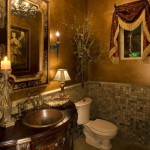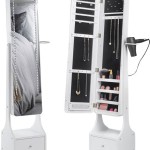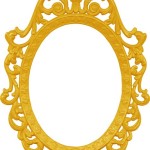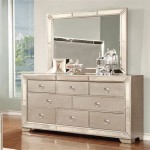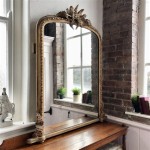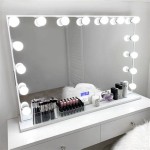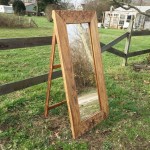How To Hang a Framed Mirror on Drywall
Hanging a framed mirror on drywall requires careful planning and execution to ensure both safety and aesthetic appeal. A properly hung mirror can enhance a room, while a poorly hung one can pose a hazard and damage the wall. This guide provides a comprehensive approach to the process, covering essential tools, techniques, and safety precautions.
Assessing the Mirror and Wall
Before initiating the hanging process, several factors must be evaluated. The weight and size of the mirror will dictate the type of hardware required. The wall material, in this case, drywall, also necessitates specific considerations. Additionally, the desired location influences the hanging method. Here are the key aspects to consider:
- Measure the mirror's dimensions and weight.
- Inspect the drywall for studs and any existing damage.
- Visualize the mirror's placement and consider surrounding decor.
Gathering Necessary Tools and Materials
Having the right tools assembled beforehand streamlines the hanging process. Improvised tools can compromise safety and efficacy. It's essential to use appropriate hardware specifically designed for hanging mirrors on drywall. The following items are typically required:
- Measuring tape
- Pencil
- Level
- Stud finder (optional but recommended)
- Drill with appropriate drill bits
- Screwdriver (if using screws)
- Hammer (if using nails)
- Wall anchors (for hanging without studs)
- Appropriate hanging hardware (D-rings, wire, etc.)
- Safety glasses
Locating and Marking Stud Placement
Studs offer the most secure anchor points in drywall. Locating them is crucial, especially for heavier mirrors. A stud finder electronically detects the presence of studs behind the drywall. Once located, mark their positions with a pencil. These markings will guide the placement of hanging hardware.
- Use a stud finder to locate studs behind the drywall.
- Mark stud locations lightly with a pencil.
- Measure and mark the desired mirror placement, considering stud locations.
Choosing and Installing Appropriate Hanging Hardware
The type of hanging hardware depends on the mirror's weight and framing. D-rings and wire are common choices. D-rings are attached to the back of the frame, while wire is strung between them. The wire is then hung on hooks or screws anchored to the wall. Choosing the correct hardware ensures secure and stable mounting.
- Select D-rings and wire appropriate for the mirror's weight.
- Securely attach D-rings to the back of the frame.
- String wire between the D-rings, ensuring proper tension.
Installing Wall Anchors (If Necessary)
If hanging the mirror on a section of drywall without studs, wall anchors are necessary. These anchors provide a secure grip within the drywall, distributing the weight of the mirror. Different types of wall anchors are available, including plastic expansion anchors and toggle bolts. The appropriate anchor type depends on the weight of the mirror.
- Select appropriate wall anchors based on the mirror's weight.
- Drill pilot holes for the anchors, following manufacturer instructions.
- Insert and secure the wall anchors into the drywall.
Hanging the Mirror Securely
Once the wall anchors (if used) or screws are in place, the mirror can be hung. Carefully lift the mirror and position the wire onto the chosen hardware. Ensure the mirror is level before releasing it completely. Double-check the stability of the hanging to prevent accidents.
- Carefully lift the mirror and position the wire on the wall hardware.
- Use a level to ensure the mirror is straight.
- Double-check the stability of the hanging.
Final Adjustments and Considerations
After hanging, minor adjustments might be necessary to perfectly align the mirror. Cleaning the mirror surface removes any fingerprints or smudges accrued during the process. Stepping back and viewing the mirror from different angles allows for assessing its placement within the room's overall aesthetic.
- Make minor adjustments to ensure perfect alignment.
- Clean the mirror surface.
- Assess the mirror's placement from different angles.
Safety Precautions Throughout the Process
Safety should be a paramount concern throughout the entire hanging process. Wearing safety glasses protects eyes from dust and debris. Handling heavy mirrors requires assistance to prevent strain or accidents. Ensuring proper weight distribution and secure fastening prevents the mirror from falling and causing injury or damage.
- Wear safety glasses.
- Enlist assistance when handling heavy mirrors.
- Ensure proper weight distribution and secure fastening.
How To Hang A 100 Pound Mirror On Drywall Quora

How To Hang A Heavy Mirror With French Cleat

How To Hang A Large Or Heavy Mirror

How To Hang A Heavy Mirror On Drywall Stas Picture Hanging Systems

How To Hang A Heavy Mirror Diy Family Handyman

How To Hang A Heavy Mirror

How To Hang A Very Heavy Picture Or Mirror The Best

How To Hang A Heavy Mirror Securely Bob Vila

How To Hang A Heavy Mirror Or Picture True Value

A Better Way To Hang Heavy Mirror Hanging Pictures

